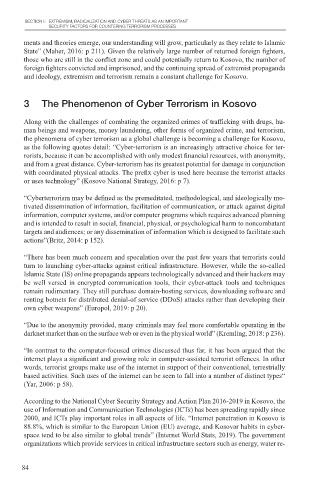Page 84 - Cyber Terrorism and Extremism as Threat to Critical Infrastructure Protection
P. 84
SECTION I: EXTREMISM, RADICALIZATION AND CYBER THREATS AS AN IMPORTANT
SECURITY FACTORS FOR COUNTERING TERRORISM PROCESSES
ments and theories emerge, our understanding will grow, particularly as they relate to Islamic
State” (Maher, 2016: p 211). Given the relatively large number of returned foreign fighters,
those who are still in the conflict zone and could potentially return to Kosovo, the number of
foreign fighters convicted and imprisoned, and the continuing spread of extremist propaganda
and ideology, extremism and terrorism remain a constant challenge for Kosovo.
3 The Phenomenon of Cyber Terrorism in Kosovo
Along with the challenges of combating the organized crimes of trafficking with drugs, hu-
man beings and weapons, money laundering, other forms of organized crime, and terrorism,
the phenomena of cyber terrorism as a global challenge is becoming a challenge for Kosovo,
as the following quotes detail: “Cyber-terrorism is an increasingly attractive choice for ter-
rorists, because it can be accomplished with only modest financial resources, with anonymity,
and from a great distance. Cyber-terrorism has its greatest potential for damage in conjunction
with coordinated physical attacks. The prefix cyber is used here because the terrorist attacks
or uses technology” (Kosovo National Strategy, 2016: p 7).
“Cyberterrorism may be defined as the premeditated, methodological, and ideologically mo-
tivated dissemination of information, facilitation of communication, or attack against digital
information, computer systems, and/or computer programs which requires advanced planning
and is intended to result in social, financial, physical, or psychological harm to noncombatant
targets and audiences; or any dissemination of information which is designed to facilitate such
actions”(Britz, 2014: p 152).
“There has been much concern and speculation over the past few years that terrorists could
turn to launching cyber-attacks against critical infrastructure. However, while the so-called
Islamic State (IS) online propaganda appears technologically advanced and their hackers may
be well versed in encrypted communication tools, their cyber-attack tools and techniques
remain rudimentary. They still purchase domain-hosting services, downloading software and
renting botnets for distributed denial-of service (DDoS) attacks rather than developing their
own cyber weapons” (Europol, 2019: p 20).
“Due to the anonymity provided, many criminals may feel more comfortable operating in the
darknet market than on the surface web or even in the physical world” (Kremling, 2018: p 236).
“In contrast to the computer-focused crimes discussed thus far, it has been argued that the
internet plays a significant and growing role in computer-assisted terrorist offences. In other
words, terrorist groups make use of the internet in support of their conventional, terrestrially
based activities. Such uses of the internet can be seen to fall into a number of distinct types“
(Yar, 2006: p 58).
According to the National Cyber Security Strategy and Action Plan 2016-2019 in Kosovo, the
use of Information and Communication Technologies (ICTs) has been spreading rapidly since
2000, and ICTs play important roles in all aspects of life. “Internet penetration in Kosovo is
88.8%, which is similar to the European Union (EU) average, and Kosovar habits in cyber-
space tend to be also similar to global trends” (Internet World Stats, 2019). The government
organizations which provide services in critical infrastructure sectors such as energy, water re-
84

